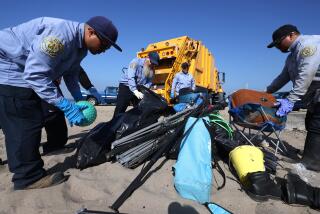Material From Sewage Plant Expansion : Plan Would Move Sand to Repair Venice Beach
Shore erosion that narrowed Venice Beach by several hundred feet this decade may be repaired with more than 1 million tons of sand excavated during the expansion of the nearby Hyperion sewage treatment plant.
Under a proposal that will soon be submitted to Los Angeles officials, contractors bidding on the next phase of construction, to begin in early 1990, would be required to move sand excavated from the plant site north to Venice.
If approved, this will be the second sand transfer organized by Gregory Woodell, a planner for the county Beaches and Harbors Department and former president of the California Shore and Beach Preservation Assn.
Workers are scheduled to complete the first transfer, consisting of 670,000 cubic yards of sand, to Dockweiler State Beach and El Segundo beach by the end of this month, Woodell said. The sand moved to the two beaches will create 22 acres of new beach, he said.
Sources of Erosion
Sand is eroded from beaches by storms and currents, Woodell said. Natural forces no longer bring new sand from inland waterways to the sea, so beaches must be artificially replenished.
“It must be done sooner or later,” Woodell said. “Venice has lost a great deal of sand.”
The beach at Venice has narrowed by 200 to 300 feet in the last 10 years. Much of that sand was lost during the series of fierce winter storms that hit the California coast during the winter of 1982-83, Woodell said.
Without new sand, the beach at Venice would eventually disappear, removing a favorite recreational spot and leaving structures along the coast vulnerable to storm damage, he said.
Beaches erode unevenly, Woodell said. So a coastal engineer must be hired to determine exactly how much to widen the beach and whether new sand is required for the entire length of the Venice coast.
Woodell’s proposal must be approved by the city’s Recreation and Parks Department, the Army Corps of Engineers and the California Coastal Commission.
Pumped Slurry
If the Venice sand transfer is approved, the most inexpensive means of moving the sand would be to mix it with seawater to form a mixture called slurry and pump it to the beach, said Walter Naydo, division engineer for Hyperion’s engineering design division.
“The contractor would dig a pit at the Hyperion site, pump seawater into it, mix it with sand, and then pump the mixture out to the beach,” Naydo said.
A 3-foot-wide pipe would extend up the beach from Hyperion through Dockweiler and Playa del Rey, dip under the Marina del Rey entrance channel and up on Venice beach.
This would not be the first time sand was carried in the form of slurry to replenish area beaches.
About 14 million cubic yards of sand excavated from the Hyperion site was placed on beaches from Dockweiler up to Will Rogers State Beach by means of slurry in the late 1940s. Another 3 million cubic yards was added to Dockweiler from 1960 to 1962 during the construction of Marina del Rey.
Same Source
Woodell prizes the sand excavated from the Hyperion site because it is from the same source that was originally used to help build the area’s beaches. The sand was tested and found to be free of toxic metals or chemicals.
“It’s good material,” Woodell said. “As long as they’ll dig it out I’ll take it.”
Naydo and Woodell were not able to estimate how much it would cost to move the excavated sand to Venice. But Naydo said the move could save money for the city.
“It is very expensive to truck the material to some landfill,” Naydo said. “If we can slurry it to the beach site, it should save us some money.”
Contractors were able to use a conveyor belt more than a mile long instead of a slurry to carry sand from Hyperion to Dockweiler and El Segundo beaches earlier this year. Once the sand arrived at the beach, workers used bulldozers to push the material into the ocean, increasing the width of the beach.
Too Expensive
However, it would be too expensive to use a conveyor belt to move sand to the Venice beach, 3 to 4 1/2 miles away, Naydo said.
Meanwhile, workers have almost completed the first sand transfer to Dockweiler and El Segundo beaches. Originally, Dockweiler was to receive 330,000 cubic yards of sand. Another 340,000 cubic yards of sand was to create a beach at El Segundo that had completely eroded.
But workers had to halt work at Dockweiler after moving about 150,000 cubic yards so as to not harm the grunion, small fish that go ashore in late March to lay their eggs.
The balance of the sand destined for Dockweiler was added to the sand intended for El Segundo, where work continued through the spring, because there was no place for the grunion to lay eggs on the eroded beach.
The beach at El Segundo will be opened to visitors by the end of this month, Woodell said.
More to Read
Sign up for Essential California
The most important California stories and recommendations in your inbox every morning.
You may occasionally receive promotional content from the Los Angeles Times.










